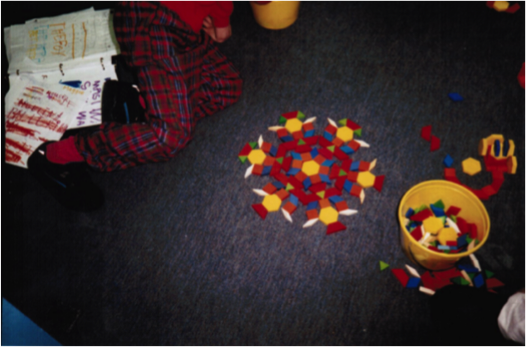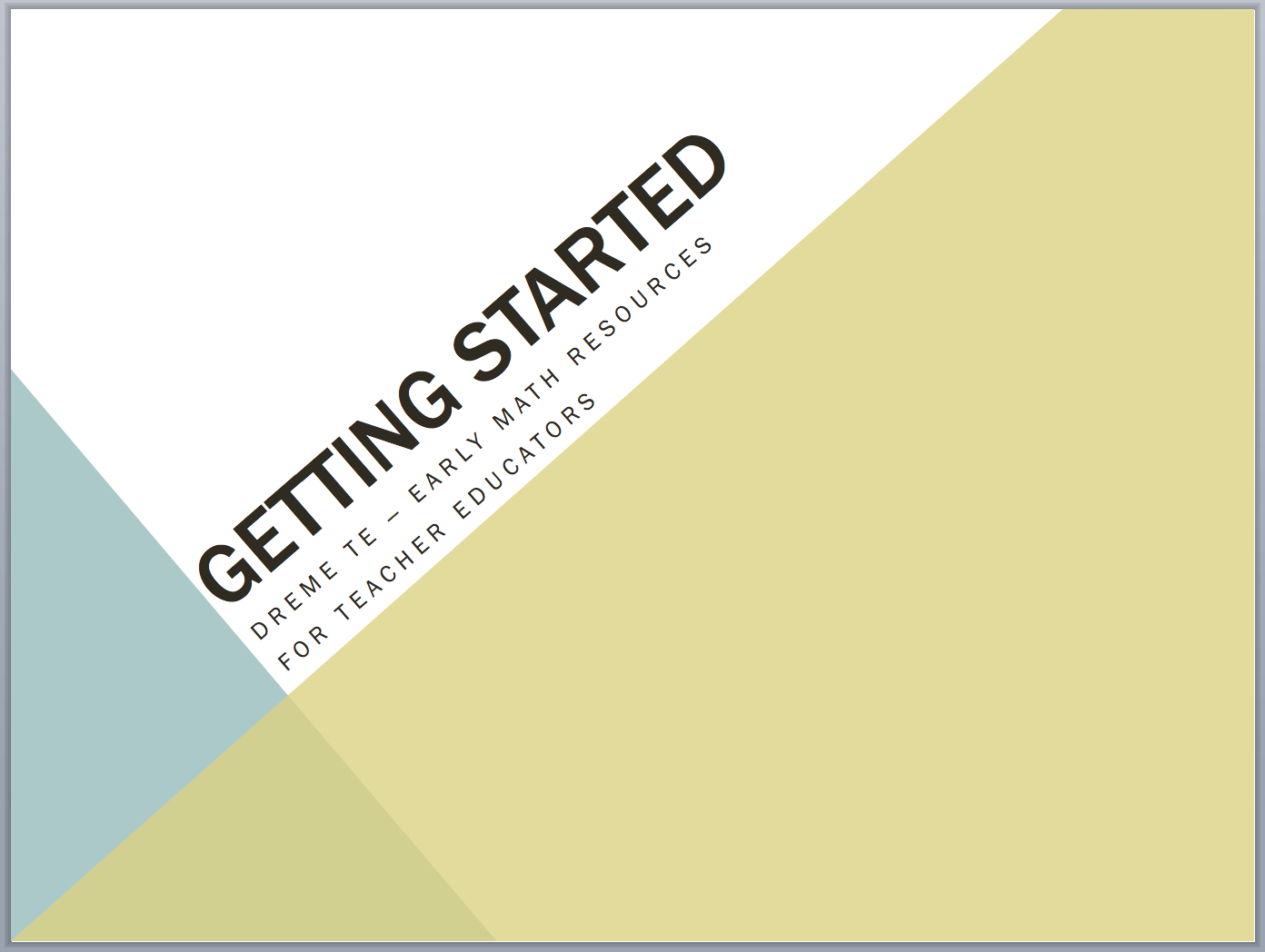There are many daily-life activities in which children engage with mathematical patterns in their everyday lives, without formal instruction. This handout describes some of these activities.
Music
Children love music, which is made up of patterns. They sing songs in which words and melodies are repeated. Just look at “B-I-N-G-O, B-I-N-G-O, B-I-N-G-O, and Bingo was his name, oh.” As the song progresses, the children sing a subtraction pattern in which the last letter is omitted: “B-I-N-G_, B-I-N-G_ , B-I-N-G_, and Bingo was his name, oh.”
Creation
 Children also create patterns themselves, as in this example from a kindergarten. One thing to note about children’s constructions is that they are often beautiful (as are this child’s pants). Another point is that the constructions may involve many shapes and intricate arrangements. This example has six columns radiating out from a yellow hexagon in the middle. It has blue pieces circling around the center, as well as squares, triangles, parallelograms, and trapezoids. It is symmetrical, with one side being a slightly imperfect reflection of the other. If you look carefully you will see that a few green triangles along the edges are missing, but when this photo was taken, the child had not yet finished the construction. At the end it was perfectly symmetrical.
Children also create patterns themselves, as in this example from a kindergarten. One thing to note about children’s constructions is that they are often beautiful (as are this child’s pants). Another point is that the constructions may involve many shapes and intricate arrangements. This example has six columns radiating out from a yellow hexagon in the middle. It has blue pieces circling around the center, as well as squares, triangles, parallelograms, and trapezoids. It is symmetrical, with one side being a slightly imperfect reflection of the other. If you look carefully you will see that a few green triangles along the edges are missing, but when this photo was taken, the child had not yet finished the construction. At the end it was perfectly symmetrical.
Left completely on their own, children can create interesting patterns. At the same time, children benefit from teachers’ provision of environments in which their pattern work is guided and taken seriously. Here is a description of the approach used by teacher Julie Diamond, in whose classroom this construction and others like it were created.
Children respond with enthusiasm and individuality to a study of patterns. Key aspects of the classroom environment allow for a maximum of engagement and learning. First, teachers must make available a variety of open-ended materials (e.g., plain wooden cubes, colored inch cubes, colored tiles, black and white tiles, pattern blocks, and the like). Second, children need an introductory period in which to acquaint themselves with the possibilities of the materials, using them freely, exploring different kinds of constructions, using the materials for pretend play, etc. After a period of exploration, the topic of pattern can be introduced, and children can use materials to create and describe different kinds of patterns. Children can be asked to record their patterns (by doing free-hand drawings or using pattern block stamps, for example), and to translate a pattern that was created with one material into another material, thus creating an equivalent pattern.
Children benefit from having work recognized and discussed by others in the group through a Work Share period and the use of photo documentation, as well as wall displays of drawn or stamped representations of work. Routines can provide structure for these aspects of classroom life. For example, after a Work Share, the child who created the pattern can routinely ask for questions or comments about it.
Note several crucial points about this teacher’s approach. It provides both a rich environment and opportunities to explore it freely. But then the teacher herself introduces the topic of patterns, and it is not simply ABABAB. She encourages different kinds of pattern constructions. Finally, she encourages thinking and talking about the patterns. Her goal is to foster careful analysis so that children develop an explicit understanding of their patterns, as well as the ability to communicate patterns to others.
Clapping
Sometimes children embody a pattern, as in the case of clapping games, which they learn from both peers and adults. Here’s a short example of Julie and Maya working together.
Note that successful clapping depends on careful attention and memory, as well as fast and accurate hand movements in the correct and fairly complex sequence.
In brief, in the everyday environment, children do indeed explore patterns and develop informal knowledge about them—more informal knowledge than adults realize or expect. But there is a great deal more for them to learn. They can learn to analyze the relations among the different pieces used in the beautiful construction shown at the beginning of this handout, for example: they can eventually learn to see that the outside of the construction involves six identical bird-like figures, each symmetric, with two white “wings” placed on each side. It is very hard to describe in words complex patterns like these. But children can make a start at it. The teacher can help by deliberately engaging children in activities using simpler patterns that are easier to analyze and communicate than the complex constructions children are able make.



